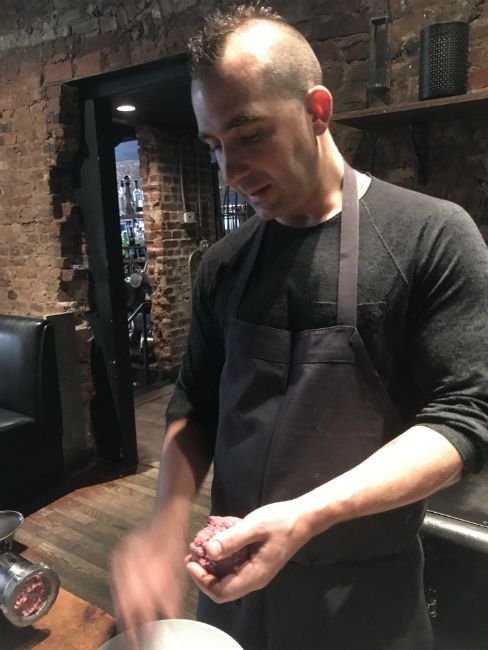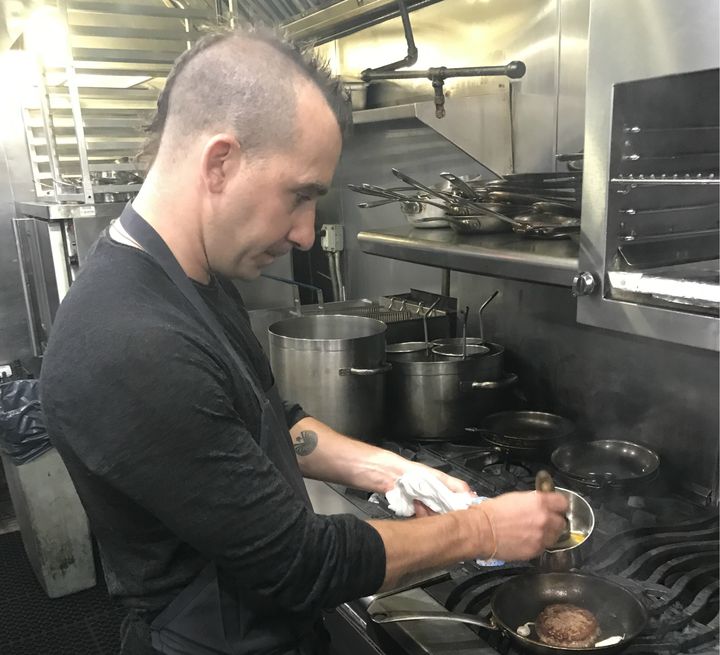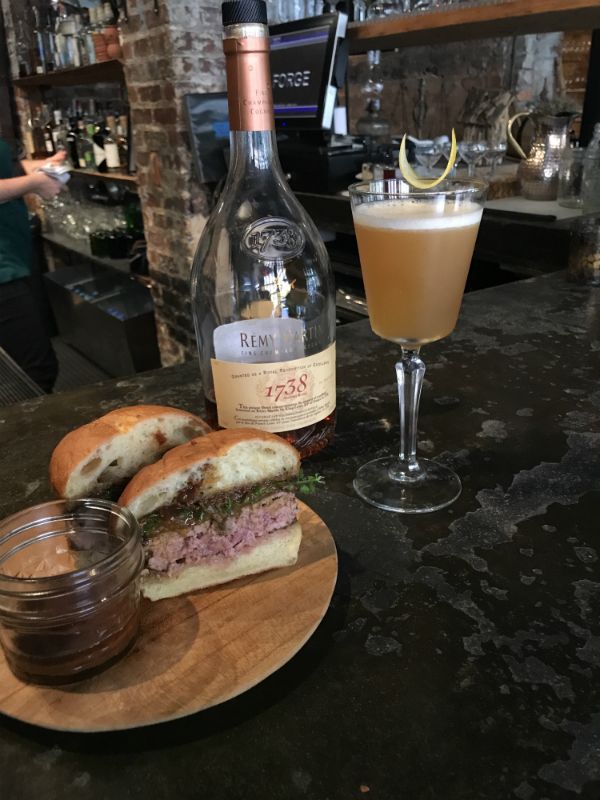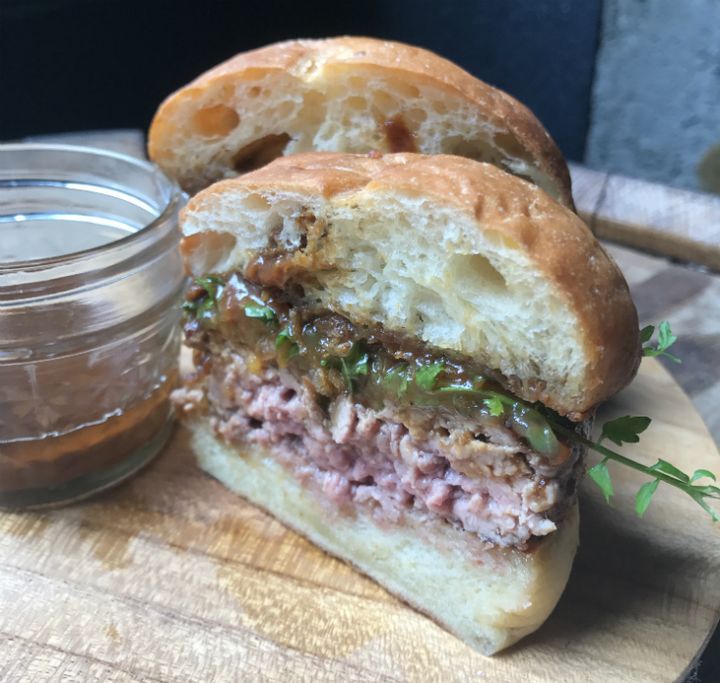Last year, while sipping a Manhattan and staring at a pile of ground beef, wondering how I could inject some pizzazz into my burger game, I was seized with a thought — what if I could make a burger that tasted like the cocktail I was drinking? After experimenting on my own, I got some of NYC’s top burger chefs involved in what I called the Manhattan (Burger) Project. You can read the mouthwatering results (and get recipes) here.
And that was that. Or so I thought at the time. But then I got to wondering about other cocktails I could subject to the burger treatment. The Sidecar — featuring two parts cognac, one part Cointreau (orange liqueur), and one part fresh squeezed lemon juice, served in a sugar-rimmed cocktail glass — isn’t the kind of drink that immediately brings burgers to mind. But hey, take five great chefs, throw a challenge their way, and they will rise to the occasion. This is the first of five articles documenting the Sidecar Burger Project; check back here for more cocktail burger deliciousness!
Marc Forgione isn’t just a legend, he’s also the son of a legend — Larry Forgione, who revolutionized American cuisine with An American Place back in the ‘70s. Marc... well, imagine if Frank Sinatra Jr. had been as gifted as his old man. Notwithstanding the Iron Chef TV appearances, the restaurant that bears his name, the most famous mohawk in the culinary world, Marc isn’t just a celebrity chef, he’s a celebrity chef. And as anyone who’s ever been to his American Cut restaurants knows, the guy has a way with beef. So I was a little surprised when I found out his Sidecar Burger would be made with dry-aged... duck? It was a first for Forgione as well as me. “Because of all the ingredients in the Sidecar — if you look at it, it’s kind of duck a l’orange,” he says. “I came up with the idea while I was traveling, so I told my chefs. And they texted me and said it’s not coming out right, blah blah blah. And then when I got here I kind of adjusted what needed to be adjusted. We found by trial and error that you want it to be cooked medium, not medium rare. It doesn’t have that same texture as beef, you know what I mean?”
For the burger, Forgione used duck breast that had been dry-aged on the bone for about two weeks, with the fat trimmed and then partially replaced: “This is very simply just the breast. I put a little bit back, I’d say it was a quarter of the fat that was left on the whole breast. Just by trial and error, we found that when you did the whole breast with the fat, it was too much.” He used a manual grinder and cranked it slowly, which turned out an intense, vivid, glistening, altogether gorgeous grind. “It’s funny,” he says, “with all the technology in the world, right? It comes out better than any machine. You can almost tell by looking at it that it’s gonna be great.”

Forgione likes to form the burger and then season it with salt and pepper on both sides. He also does something I’ve never seen before, which is make sure the burger is sized to fit the house-made bun (he likes potato buns but recommends brioche in the recipe below). It seems like a no-brainer, but I’d never even thought about it, even when I’m whining about excessive meat overhang on a Shake Shack burger. “One general rule of thumb, make sure it fits.” The roughly inch-thick patty makes a slight corona outside the bun. “It’s gonna render a little bit, so that should be a perfect size. You call it burger to bun ratio.”
Forgione cooks the duck in a pan; he’s not a member of the frequent-flipper club when it comes to burgers — “Once you put it in, don’t touch it.” “Oh, that’s interesting,” I say. “I always muck about with my burgers.”
“Everybody does. Everybody likes to shake it and get the flames and flip it.” He cooks it over high heat, flipping once, and that’s all she wrote. You need good burger intuition to not flip them constantly, but hey, that’s why he’s the one cooking and I’m the one watching.

Marc Forgione pan-fries his duck Sidecar Burger.
So the burger’s cooking, everything’s good to go, and I’m thinking, OK, where’s the cognac and the Cointreau? Now please note that when I laid down my guidelines for a Sidecar burger, I merely said that it had to replicate the flavor profile of the cocktail, not the actual ingredients. But to my surprise, not a drop of booze is to be found in this booze-inspired burger. Instead, he goes for an onion marmalade flavored with orange juice to replicate the Cointreau, and standing in for the cognac, a peanut barbecue sauce (he also uses crispy fried shallots, which don’t taste like booze but do taste delicious). I can’t say I’ve ever sipped a cognac and thought of peanuts, but I decide to reserve judgement until tasting it. When I note the lack of alcohol, he says, “You don’t always have to be so literal. And besides, there’s booze in the cocktail. Why do you need it in the food?”
A few minutes later, on my first bite, everything makes sense. The peanut sauce and the onion marmalade interact in a remarkably similar way to the cognac and Cointreau in a sidecar, with the onion marmalade capturing those deep fruity notes, and the peanut sauce — particularly the Worcestershire and chili powder in the peanut sauce, I’d guess — implying the drier elements of the cognac, right down to the spicy, almost alcoholic kick on the finish. Using duck for the burger was a brilliant call, as the condiments simply wouldn’t have worked with beef. Cooking it to medium firmed it up without drying it out; this is one of the most succulent burgers I’ve ever tried, tender without being mushy, standing up to the bun without overwhelming it.

Marc Forgione’s Sidecar Burger with Remy Martin 1738 Sidecar
The burger paired well with Forgione’s unorthodox Sidecar cocktail, made with Remy Martin 1738 cognac and a spiced pear liqueur in place of Cointreau, making the drink brighter and less sweet than a traditional Sidecar. It’s an interesting contrast to the burger, which, though in meat form, almost tastes more like a classic Sidecar than the drink. Weird, ain’t it?
The Remy Martin 1738 Sidecar is on the menu at Restaurant Marc Forgione in downtown NYC. The burger, alas, is not, although if he’s around and you request it politely, you never know. Thankfully, the recipe for the burger and all the fixin’s is right here, so you can make your own. Stay tuned for more delicious Sidecar Burger recipes!

Does that look gorgeous or what?! And it tasted just as good.
Marc Forgione’s SIdecar Burger (makes 4 burgers)
For the onion marmalade:
1 whole onion, sliced thin
2 tbl canola oil
¼ cup brown sugar
1 cup orange juice
1 tsp freshly cracked black pepper
½ cup water
salt to taste
Heat the oil in a medium sauté pan over medium-high heat and sweat the onions until translucent. Add brown sugar and stir until dissolved. Add orange juice and water and simmer until the mixture thickens to a marmalade consistency. Add salt to taste.
For the peanut sauce:
2 tbsp fresh lemon juice
¼ cup molasses
2 tbsp Worcestershire sauce
2 tbsp vegetable oil
1 tbsp plus 1 tsp cider vinegar
¾ c beer
1 tsp pure chile powder
½ tsp minced garlic
¼ tsp dried oregano
¼ tsp dried thyme
½ tsp dry mustard
½ tsp salt
1/8 tsp cayenne
1 bay leaf
¼ c natural creamy peanut butter
Place all ingredients in a medium saucepan and bring to boil, stirring constantly. Lower the heat and simmer 3-4 minutes. Remove bay leaf and let cool.
For the Crispy Shallots:
Canola oil
3 shallots, thinly sliced crosswise
[1/2] cup all-purpose flour
Kosher salt
Add enough oil to a Dutch oven to come up 1[1/2] inches up the sides and heat the oil over medium-high heat until it registers 300 degrees F on a deep-frying thermometer. Toss the shallots in the flour until well coated. Using a strainer, shake the excess flour off. Fry the onions for about 30 seconds, or until crispy. Transfer the onions to a paper towel–lined tray and season with salt.
For the duck burgers:
24 ounces of duck breast, ground
duck fat
1 garlic clove (unpeeled, crushed)
4 sprigs fresh thyme
4 brioche buns
Shape duck meat into 4 (6 ounce) patties. Place on parchment paper that has been greased with duck fat so it doesn’t stick. In a large sauté pan, melt 3 tbsp duck fat over medium-high heat until hot. Cook burgers on each side for 2 minutes. Add garlic and thyme to the pan and baste the burgers for 1 minute. Remove burgers and rest for 5 minutes. Toast buns in remaining duck fat in pan.
To assemble:
Brush top of brioche bun with peanut bbq sauce. Place duck burger on bottom brioche bun, top with onion marmalade and crispy shallots and top of brioche bun.
